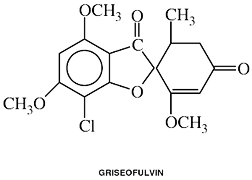

Griseofulvin
Brand Names: Fulvicin, Grifulvin V, Grisovin FP, Gristatin, Gris-PEGPlease read the disclaimer concerning the intent
and limitations of the information provided here.
The information presented in Interactions is for
informational and educational purposes only. It is based on scientific
studies (human, animal, or in vitro), clinical experience, case
reports, and/or traditional usage with sources as cited in each
topic. The results reported may not necessarily occur in all
individuals and different individuals with the same medical conditions
with the same symptoms will often require differing treatments. For
many of the conditions discussed, treatment with conventional medical
therapies, including prescription drugs or over-the-counter
medications, is also available. Consult your physician, an
appropriately trained healthcare practitioner, and/or pharmacist for
any health concern or medical problem before using any herbal products
or nutritional supplements or before making any changes in prescribed
medications and/or before attempting to independently treat a medical
condition using supplements, herbs, remedies, or other forms of
self-care.
![]()
Do not rely solely on the information in this article.
References
Anonymous. Vitamin E boosts griseofulvin. Mycol Observer. Nov/Dec 1990:8. (Letter)
Becker G. [Foods as interfering factors in pharmacotherapy--shown by various examples].
Med Welt. 1978 Jul 28;29(29-30):1163-1166. (Review) [Article in German]
Fuller R, Gibson GR. Modification of the intestinal microflora using probiotics and
prebiotics. Scand J Gastroenterol Suppl 1997;222:28-31.
Abstract: Probiotics and prebiotics modulate the composition of the human gut microbiota. The beneficial effects may result from suppression of harmful microorganisms or stimulation of organisms which contribute in a positive way to the nutrition and health of the host. Both types of supplement represent an attempt to reconstitute the gut flora to its normal composition which has been adversely affected by dietary and environmental stresses.
Kasper H. Protection against gastrointestinal diseases--present facts and future developments.
Int J Food Microbiol 1998 May 26;41(2):127-131.
Abstract: The importance of the intestinal microflora and, more specifically its composition, in physiological and pathophysiological processes in the human GIT is becoming more evident. Examples of such processes are translocation, the production and resorption of endotoxins, immune-modulation, and colonic motility. This leads to new possibilities for prevention and therapy of diseases, mainly of the gastrointestinal organs. New discoveries are specifically related to the beneficial effects of lactobacilli which have been discussed for decades. It is possible to increase the proportion of lactobacilli in the gastrointestinal microflora by consumption of fermented dairy products or by oral administration of specific non-digestible substrates such as oligofructose. Results from clinical trials and scientific studies have confirmed the preventive and therapeutic effects of selected strains of lactobacilli in viral- and bacterial-induced intestinal infections, in positively influencing immunological parameters, in normalizing the intestinal motility, and in inhibiting metabolic events in the gut lumen which promote colonic carcinogenesis. Nevertheless, there are still unresolved issues which can only be answered by well designed and well controlled clinical trials.
Lashmanova AP, Omel'chenko OG, Akimov VG. [The dynamics of the griseofulvin levels in the blood and skin of guinea pigs during its combined use with alpha-tocopherol].
Vestn Dermatol Venerol 1990;9:15-16. [Article in Russian]
Abstract: Experiments with 120 guinea pigs have revealed that skin griseofulvin levels depend on blood griseofulvin level and reduce after a prolonged (for 3-4 weeks) administration of the antibiotic in a dose of 30 mg/kg. Reduction of P-450 system enzymes activities achieved with alpha-tocopherol slows down griseofulvin biotransformation rate and significantly elevates its blood serum and skin concentrations.
Leshchenko VM, Omel'chenko OG, Poliakova IIa, Klimova IIa. [Treatment of patients with zooanthroponotic microsporosis with griseofulvin in combination with alpha-tocopherol].
Vestn Dermatol Venerol. 1988;(12):24-26. [Article in Russian]
Omel'chenko OG. [Dynamics of the concentration of griseofulvin in the blood and urine when used jointly with alpha-tocopherol].
Vestn Dermatol Venerol. 1987;(8):12-15. [Article in Russian]
Rasool AA, Hussain AA, Dittert LW. Solubility enhancement of some water-insoluble drugs in the presence of nicotinamide and related compounds.
J Pharm Sci 1991 Apr;80(4):387-393.
Abstract: The solubilities of five poorly water-soluble drugs, diazepam, griseofulvin, progesterone, 17 beta-estradiol, and testosterone, were studied in the presence of nicotinamide. All solubilities were found to increase in a nonlinear fashion as a function of nicotinamide concentration. The K1:1 and K1:2 stability constants were as follows: for diazepam, K1:1 = 5.23 M-1 and K1:2 = 8.6 M-2; for griseofulvin, K1:1 = 5.54 M-1 and K1:2 = 8.82 M-2; for progesterone, K1:1 = 5.48 M-1 and K1:2 = 42.47 M-2; for 17 beta-estradiol, K1:1 = 5.38 M-1 and K1:2 = 36.9 M-2; and for testosterone, K1:1 = 5.07 M-1 and K1:2 = 27.47 M-2. Two aliphatic analogues of nicotinamide (nipecotamide and N,N-dimethylacetamide) were studied as ligands with diazepam and griseofulvin and were found to increase the solubilities of both drugs in a linear fashion. The aromatic analogue, N,N-diethylnicotinamide, showed a nonlinear solubilization relationship similar to that seen with nicotinamide. In addition, three other aromatic analogues (isonicotinamide, 1-methylnicotinamide iodide, and N-methylnicotinamide) were studied. These ligands were not soluble enough in water to be studied over the wide range of concentrations used for nicotinamide and N,N-diethylnicotinamide; however, in the concentration range studied, these ligands solubilized diazepam and griseofulvin to a degree similar to that observed with comparable concentrations of nicotinamide. These results suggest that the aromaticity (Pi-system) of the pyridine ring is an important factor in complexation because the aromatic amide ligands were found to enhance the aqueous solubilities of the test drugs to a greater extent than the aliphatic amide
ligands.